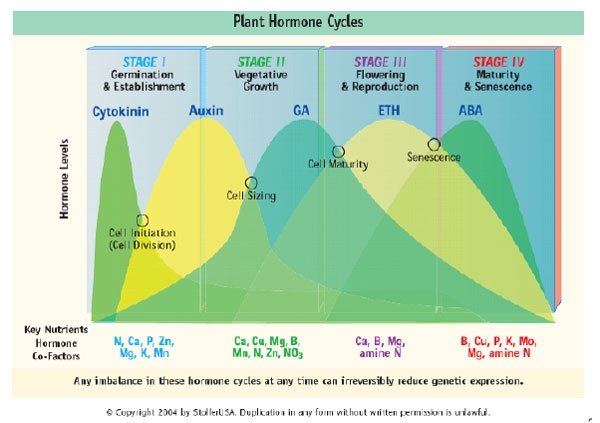Throughout the growing stages of a tree the requirements for nutrients and hormones change.
This is an area that the worldwide Stoller Group has been researching for a number of years. Stoller has developed a graph that shows how the natural hormone cycles in a plant change throughout the season and the nutrients that are important at the different growth stages (see Figure 1).
Growth stages
After budburst
After budburst, as the plant becomes vegetative, the tree is driven by stored nitrogen (in the form of amino acids such as argenine) and also needs key elements such as phosphorus, calcium, zinc and other micronutrients.
At the beginning of this stage, the roots can be inactive, so it is important that the tree has stored or can access the critical nutrients.
Reproductive stage
As the vegetative stage moves into the reproductive stage, a range of nutrients are required to feed the healthy growth and assist in the transition into reproductive stage.
At this time nitrate nitrogen is less desirable and amine N along with calcium and boron become important.
Maturity
As reproductive stage moves into maturity, potassium copper and molybdenum become more important, with phosphorus remaining critical for energy transfer.
Crop maturity and fruit filling
This later period of growth is when the money is made.
The leaves have produced sugars and the sugars must be transported to the fruit. There are a number of mechanisms that allow this process to happen smoothly.
Not too much nitrate
Nitrogen should be ramping down now and nitrate nitrogen tends to push vegetative growth.
Adequate molybdenum is also important so that the plant can break the nitrates down.
Adequate potassium
Potassium (K) moves out of the cells with the sugar into the phloem and on to the fruit.
There must be enough potassium in the tree to allow this.
Phosphorus
Phosphorus (P) is an energy source and P tends to move to the newly developing tissue in the plant— there must be a supply of P as the crop is filling.
The role of magnesium
Magnesium (Mg) drives the enzyme pump that moves the sugars, inadequate magnesium can mean inadequate fuel for the pump (see Figure 2).
Boron
Boron (B) helps with cell permeability and sugar movement. It can also control the movement of auxin and in doing so, take away the apical dominance of the tree.
Copper
Nutrient copper (Cu) is an essential micronutrient and it also tends to lift anthocyanin levels.
When used with the other Stage IV elements (see Figure 1) it can help the colouring of fruit.
Hormones
All these elements play a role in the proper filling and maturity of the fruit.
Abscisic Acid (ABA) and Ethylene (ETH) are the hormones that are elevated at the late crop stages and they play an important role in the finishing of the fruit and the dormancy of the tree.
For more information, contact Richard Emery phone 08 8244 9588 mobile 0417 871807
For information see Tree Fruit January 2014






















